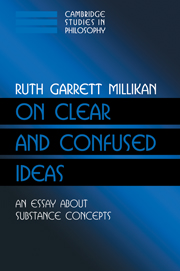Book contents
- Frontmatter
- Contents
- Preface
- Chapter 1 Introducing Substance Concepts
- Chapter 2 Substances: The Ontology
- Chapter 3 Classifying, Identifying, and the Function of Substance Concepts
- Chapter 4 The Nature of Abilities: How Is Extension Determined?
- Chapter 5 More Mama, More Milk and More Mouse: The Structure and Development of Substance Concepts
- Chapter 6 Substance Concepts Through Language: Knowing the Meanings of Words
- Chapter 7 How We Make Our Ideas Clear: Epistemology for Empirical Concepts
- Chapter 8 Content and Vehicle in Perception
- Chapter 9 Sames Versus Sameness in Conceptual Contents and Vehicles
- Chapter 10 Grasping Sameness
- Chapter 11 In Search of Strawsonian Modes of Presentation
- Chapter 12 Rejecting Identity Judgments and Fregean Modes
- Chapter 13 Knowing What I'm Thinking Of
- Chapter 14 How Extensions of New Substance Concepts are Fixed: How Substance Concepts Acquire Intentionality
- Chapter 15 Cognitive Luck: Substance Concepts in an Evolutionary Frame
- Appendix A Contrast with Evans on Information-Based Thoughts
- Appendix B What Has Natural Information to Do with Intentional Representation?
- References
- Index
Chapter 14 - How Extensions of New Substance Concepts are Fixed: How Substance Concepts Acquire Intentionality
Published online by Cambridge University Press: 02 December 2009
- Frontmatter
- Contents
- Preface
- Chapter 1 Introducing Substance Concepts
- Chapter 2 Substances: The Ontology
- Chapter 3 Classifying, Identifying, and the Function of Substance Concepts
- Chapter 4 The Nature of Abilities: How Is Extension Determined?
- Chapter 5 More Mama, More Milk and More Mouse: The Structure and Development of Substance Concepts
- Chapter 6 Substance Concepts Through Language: Knowing the Meanings of Words
- Chapter 7 How We Make Our Ideas Clear: Epistemology for Empirical Concepts
- Chapter 8 Content and Vehicle in Perception
- Chapter 9 Sames Versus Sameness in Conceptual Contents and Vehicles
- Chapter 10 Grasping Sameness
- Chapter 11 In Search of Strawsonian Modes of Presentation
- Chapter 12 Rejecting Identity Judgments and Fregean Modes
- Chapter 13 Knowing What I'm Thinking Of
- Chapter 14 How Extensions of New Substance Concepts are Fixed: How Substance Concepts Acquire Intentionality
- Chapter 15 Cognitive Luck: Substance Concepts in an Evolutionary Frame
- Appendix A Contrast with Evans on Information-Based Thoughts
- Appendix B What Has Natural Information to Do with Intentional Representation?
- References
- Index
Summary
WHAT DETERMINES THE EXTENSIONS OF NEW SUBSTANCE CONCEPTS?
In the first section of this chapter, I will use the results of the last chapter to explain more exactly how the extension of a substance concept is fixed. I will be concerned, especially, with how the extensions of new substance concepts, acquired directly on first meeting with their referents, are fixed. The rest of the chapter will be devoted to fitting the theory of substance concepts defended here into the more general theory of intentional representation developed in Millikan (1984, 1993a).
Evans concluded, about the man with the memory of the ball he was unable to identify, that the man did not have the capacity to think of that ball at all, but only to think of a ball (Section 13.4). But, I have argued, the question whether he could think of that individual ball doesn't turn on whether he was actually able to reidentify it. It doesn't turn on whether his situation was right for reidentifying it. It depends, rather, on whether his thought was produced by his cognitive systems in such a way as to have, as its first assigned function, that it be coidentified, specifically, with thoughts of that particular ball. And to that question the answer would seem to be yes.
As Evans describes the case, when the man was looking at the ball he understood it to be an individual ball, indeed, one that happened to be steel and shiny.
- Type
- Chapter
- Information
- On Clear and Confused IdeasAn Essay about Substance Concepts, pp. 193 - 202Publisher: Cambridge University PressPrint publication year: 2000

